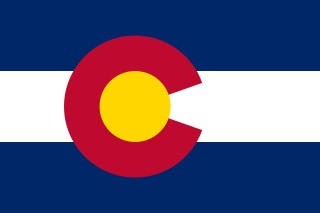
Platanthera praeclara, known as the western prairie fringed orchid and the Great Plains white fringed orchid, is a rare and threatened species of orchid native to North America.

Platanthera leucophaea, commonly known as the prairie white fringed orchid or eastern prairie fringed orchid, is a rare species of orchid native to North America. It is listed as a threatened species in the United States on September 28, 1989. The IUCN does not currently recognize it as being at risk.
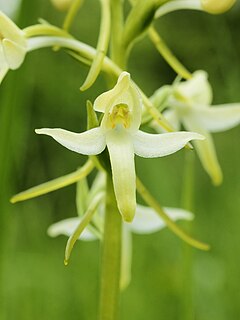
The genus Platanthera belongs to the subfamily Orchidoideae of the family Orchidaceae, and comprises about 100 species of orchids. The members of this genus, known as the butterfly orchids or fringed orchids, were previously included in the genus Orchis, which is a close relative. They are distributed throughout the temperate regions of the Northern Hemisphere. They are terrestrial and have tubercules.
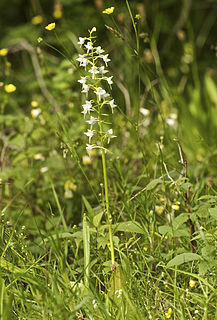
Platanthera chlorantha, commonly known as greater butterfly-orchid, is a species of orchid in the genus Platanthera. It can be found throughout Europe and Morocco. The name Platanthera is derived from Greek, meaning "broad anthers", while the species name, chlorantha, means "green-flowered".

Platanthera yosemitensis, the Yosemite bog orchid, is a species of orchid that is endemic to nine wet montane meadows between the main stem and the South Fork of the Merced River in Yosemite National Park.

Platanthera blephariglottis, commonly known as the white fringed orchid or white-fringed orchis, is a species of orchid of the genus Platanthera. It is considered to be an endangered species in Connecticut and Ohio, a threatened species in Florida, Maryland and Rhode Island, exploitably vulnerable in New York, and susceptible to be threatened in Québec.

Boechera sparsiflora is a species of rockcress known by the common names sicklepod rockcress and elegant rockcress. It is native to western North America from California to Utah to Yukon, where it can be found in a number of habitats. This is a coarsely hairy perennial herb growing one or more thick stems from a caudex. The stem may branch or not and it reaches up to 90 centimeters in maximum height. The leaves vary in shape from linear to arrowhead-like and may or may not have toothed edges. They are usually hairy and up to 8 or 10 centimeters long. The raceme inflorescence bears a number of flowers with spoon-shaped petals about a centimeter long in shades of purple or pink. The fruit is a large, curved silique 6 to 12 centimeters long

Collinsia sparsiflora is a flowering plant in the family Plantaginaceae known by the common names spinster's blue-eyed Mary and few-flowered collinsia. One variety of the species is native to the West Coast of the United States as far north as Washington, while the other three varieties are limited to California alone.
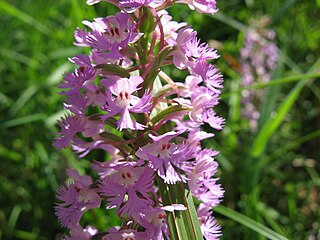
Platanthera psycodes, commonly called lesser purple fringed orchid or small purple-fringed orchid, is a species of orchid, genus Platanthera, occurring from eastern Canada to the east-central and northeastern United States. It is imperiled in Illinois, Tennessee, North Carolina, and Kentucky.
Piperia candida is a species of orchid known by the common names whiteflower rein orchid, slender white piperia, and white-flowered piperia. It is native to western North America from Alaska to the San Francisco Bay Area, where it grows in coniferous forests and other habitat in coastal and inland mountain ranges within 150 kilometers of the coast. It grows erect to about half a meter in maximum height from a bulbous caudex. The basal leaves are up to 18 centimeters long by 3 wide. Leaves higher on the stem are much reduced. The upper part of the stem is a spikelike inflorescence of up to 100 small flowers, mostly arranged along one side of the stem. The fragrant, honey-scented flowers are whiter than those of other Piperia, but sometimes green-tinged or -veined, or green with white margins. The status of this species in the wild is difficult to determine because most populations are small and may produce flowers only rarely.
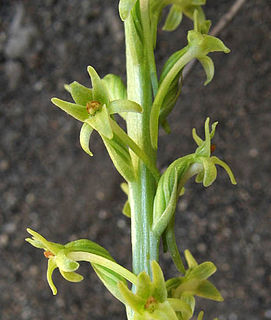
Piperia elongata is a species of orchid known by the common names denseflower rein orchid, chaparral orchid and wood rein-orchid. It is native to western North America from British Columbia and Montana to southern California, where it grows in mountain forests and scrub habitat. This orchid grows erect to about 1.3 meters in maximum height from a bulbous caudex, its stem becoming narrow toward the tip. The basal leaves are up to 30 centimeters long by 6.5 wide. Leaves higher on the stem are much reduced. The upper part of the stem is a spikelike inflorescence of many small green flowers which are sometimes densely arranged. They are sometimes faintly and variably fragrant in the evenings. The spur on each flower may be up to 1.5 centimeters long.
Piperia leptopetala is a species of orchid known by the common names narrow-petal rein orchid, and lacy rein orchid. It is native to the west coast of the United States from Washington to California, where it grows in scrub and woodland habitat in mountains and foothills. This orchid grows erect to about 70 centimeters in maximum height from a bulbous caudex. The basal leaves are up to 15 centimeters long by 3 wide. Leaves higher on the stem are much reduced. The upper part of the stem is a spikelike inflorescence of many delicate, translucent green flowers which are sometimes fragrant in the evenings. This rein orchid has narrower petals than those of other species, giving the inflorescence a lacy look, as the common names suggest.

Piperia michaelii is an uncommon species of orchid known by the common names Michael's rein orchid and Michael's piperia. It is endemic to California, where it is known from the coastal plains, hills, and mountains, and the Sierra Nevada foothills. It can be found in varied habitat, including scrub, woodland, and forest. This orchid grows erect to about 70 centimeters in maximum height from a bulbous caudex. The basal leaves are up to 24 centimeters long by 5 wide. Leaves higher on the stem are much reduced. The upper part of the stem is a spikelike inflorescence of many yellow-green flowers which are fragrant in the evenings.

Piperia transversa, is a species of orchid known by the common names royal rein orchid and flat spurred piperia.

Platanthera stricta is a species of orchid known by the common name slender bog orchid. It is native to western North America from Alaska and Yukon south to Utah and northern California.
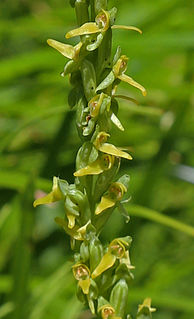
Platanthera tescamnis, the intermountain bog orchid or yellow rein orchid, is a species of orchid described in 2006. The plant is well-known but had been misidentified. It is native to the Great Basin and Colorado Plateau of the western United States, where it grows in warmer, drier habitat than most related orchids.
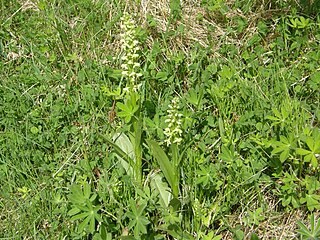
Platanthera hyperborea, the northern green orchid, is small orchid found only in Greenland, Iceland, and Akimiski Island in Canada. Numerous authors cite the species as widespread in other parts of Canada and also in the United States; such populations are more correctly referred to as Platanthera aquilonis.
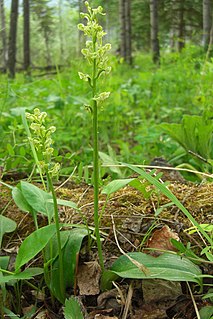
Platanthera obtusata, common name blunt-leaved orchid or small northern bog orchid, is a small species of orchid in the genus Platanthera. It widespread across much of the colder regions of the Northern Hemisphere, though rare in some parts of its range. Two subspecies are recognized:

Platanthera flava, the palegreen orchid, is a species of pale-flowered orchid. It is native to eastern North America, from Texas east to Florida, north to Ontario, Quebec and Nova Scotia.

Platanthera lacera is an orchid in the genus Platanthera, native throughout Eastern United States and Canada. It occurs in a variety of habitats ranging from “mesic and dry-mesic sand prairie, wet sedge meadow, calcareous fen, sphagnum bog, acid seep spring, dry field, mesic flatwoods, and mesic upland forests.” Common names include ragged fringed orchid and green fringed orchid.


